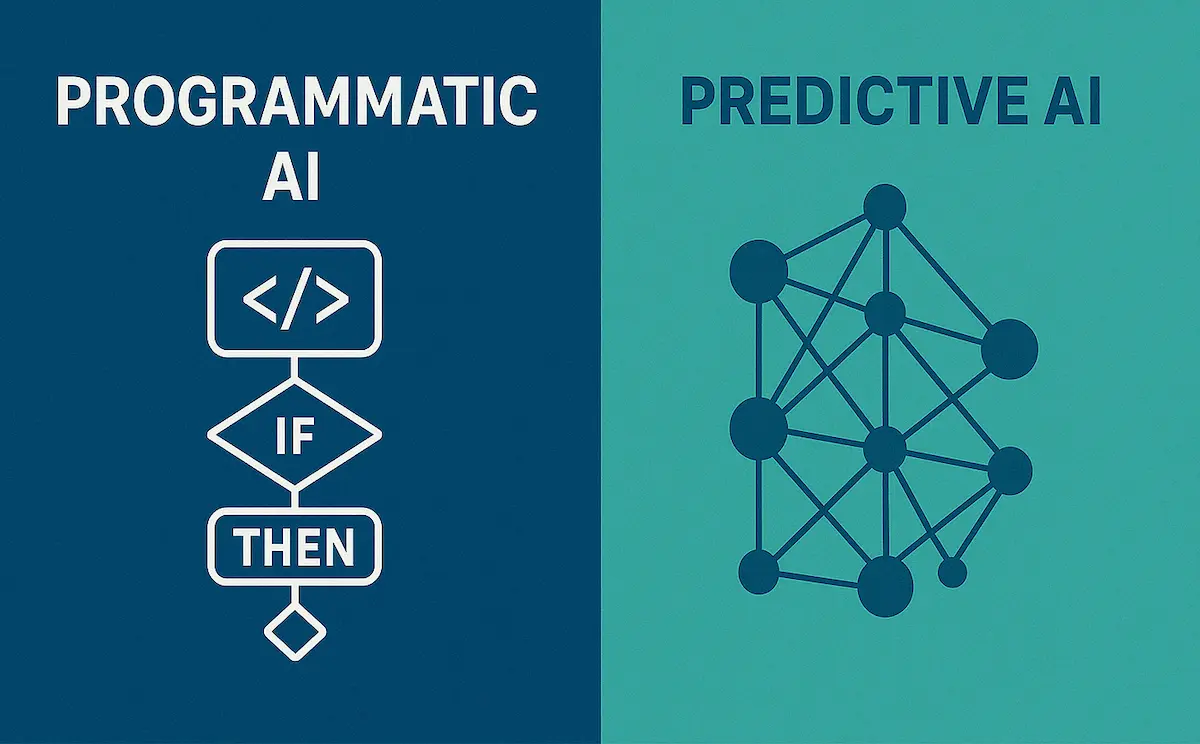Introduction
As artificial intelligence matures, organizations are confronted with multiple AI paradigms—each suited to different challenges. Two of the most prominent approaches are Programmatic AI, which follows predefined rules and logical workflows, and Predictive AI, which learns patterns from data to forecast outcomes. Understanding the nuances between these paradigms is critical for selecting the right solution for your use case, maximizing ROI, and ensuring scalability.
What Is Programmatic AI?
Programmatic AI, sometimes referred to as rule‑based or deterministic AI, operates according to explicitly coded rules and business logic. Its core characteristics include:
- Deterministic Behavior: Every input maps to a predictable output via a sequence of if‑then‑else rules.
- Transparent Logic: Rules are human‑readable and auditable, making compliance and debugging straightforward.
- Low Data Requirements: Since behavior is encoded manually, programmatic AI can be deployed with minimal training data.
- Fast Inference: Rule evaluation is computationally inexpensive, resulting in low latency.
Common Use Cases:
- Data Validation & Cleansing: Enforcing formatting, range checks, and cross‑field consistency.
- Decision Trees & Expert Systems: Embedding domain expertise (e.g., medical diagnosis support, loan‑approval workflows).
- Business Process Automation: Automating standard operating procedures in finance, HR, and supply chain management.
What Is Predictive AI?
Predictive AI leverages machine learning algorithms—such as regression, classification, and time‑series forecasting—to learn patterns from historical data and predict future outcomes. Its hallmarks include:
- Data‑Driven Modeling: Models adjust weights based on large volumes of labeled or unlabeled data.
- Probabilistic Outputs: Predictions often come with confidence scores, enabling risk‑aware decision making.
- Adaptability: Models can continuously retrain with new data to improve accuracy over time.
- Complex Pattern Recognition: Able to capture nonlinear relationships and interactions that are difficult to encode manually.
Common Use Cases:
- Sales & Demand Forecasting: Predicting customer demand to optimize inventory and supply chain.
- Churn Prediction: Identifying customers at risk of attrition based on usage patterns.
- Anomaly Detection: Spotting unusual events in network traffic, financial transactions, or manufacturing sensors.
- Personalization & Recommendation: Tailoring content and product suggestions by learning user behavior.
Key Differences at a Glance
| Aspect | Programmatic AI | Predictive AI |
|---|
| Logic Source | Explicitly coded rules | Learned from historical data |
| Transparency | High (easy to audit) | Medium (model interpretability varies) |
| Data Requirement | Low | High (needs quality training data) |
| Adaptability | Static until rules are updated | Dynamic via retraining |
| Complexity Handling | Limited to predefined scenarios | Handles nonlinear, high‑dimensional patterns |
| Latency | Very low | Variable (depends on model complexity) |
When to Use Programmatic AI
- Regulated Environments: Where explainability and audit trails are mandatory (e.g., healthcare, finance).
- Well‑Defined Logic: Tasks with stable, well‑documented workflows that rarely change.
- Resource Constraints: Projects with limited data, tight latency requirements, or minimal compute resources.
- Prototyping: Quick proof‑of‑concepts where building rule sets is faster than gathering and labeling data.
Related read: How We Automated P&ID Annotation with Programmatic AI
When to Use Predictive AI
- Dynamic Markets: Environments where patterns evolve rapidly (e.g., stock markets, consumer behavior).
- Complex Data Relationships: Use cases involving images, speech, or high‑dimensional sensor data.
- Scalable Insights: When scaling manual rule creation becomes impractical as variables and scenarios proliferate.
- Continuous Improvement: Applications that benefit from ongoing model retraining to refine predictions.
Implementation Considerations
-
Data Strategy:
- For Predictive AI, establish pipelines for data collection, cleaning, labeling, and governance.
- For Programmatic AI, document rule logic thoroughly and version‑control rule sets.
-
Hybrid Approaches:
- Combine both paradigms—e.g., use programmatic rules for initial data validation, then feed clean data into predictive models.
- Employ “rule masking” to override model outputs when regulatory or safety thresholds are breached.
-
Model Monitoring & Maintenance:
- Track drift, accuracy, and performance metrics for predictive models.
- Periodically review and update rule sets to reflect business changes.
-
Explainability & Compliance:
- Integrate explainable AI (XAI) tools for predictive models to meet audit requirements.
- Maintain clear documentation of rule logic for programmatic systems.
Choosing the Right AI Strategy
| Scenario | Recommended Approach |
|---|
| Low data availability; need for auditability | Programmatic AI |
| High‑risk, regulated environment | Programmatic (or hybrid) |
| Vast historical data; need for future forecasting | Predictive AI |
| Complex sensor/image/video processing | Predictive (deep learning) |
| Rapidly evolving business conditions | Predictive with retraining |
In many real‑world deployments, the hybrid of programmatic and predictive AI offers the best of both worlds: the precision and compliance of rule‑based systems with the adaptability and scalability of machine learning.
Conclusion & Next Steps
Navigating the AI landscape requires a clear understanding of both programmatic and predictive paradigms. Start by:
- Auditing Your Requirements: Identify where transparency, latency, or data complexity are paramount.
- Mapping Use Cases: Align each task to the paradigm that best addresses its constraints and objectives.
- Prototyping with Minimal Viable Solutions: Build a small rule‑based workflow or a simple predictive model to validate the approach.
- Planning for Scale: Design data pipelines and rule‑management frameworks that support future growth and regulatory needs.
Ready to accelerate your AI journey? Schedule a discovery call to explore how our AI experts can help you architect a hybrid solution tailored to your business goals or Explore our Product Suite.
